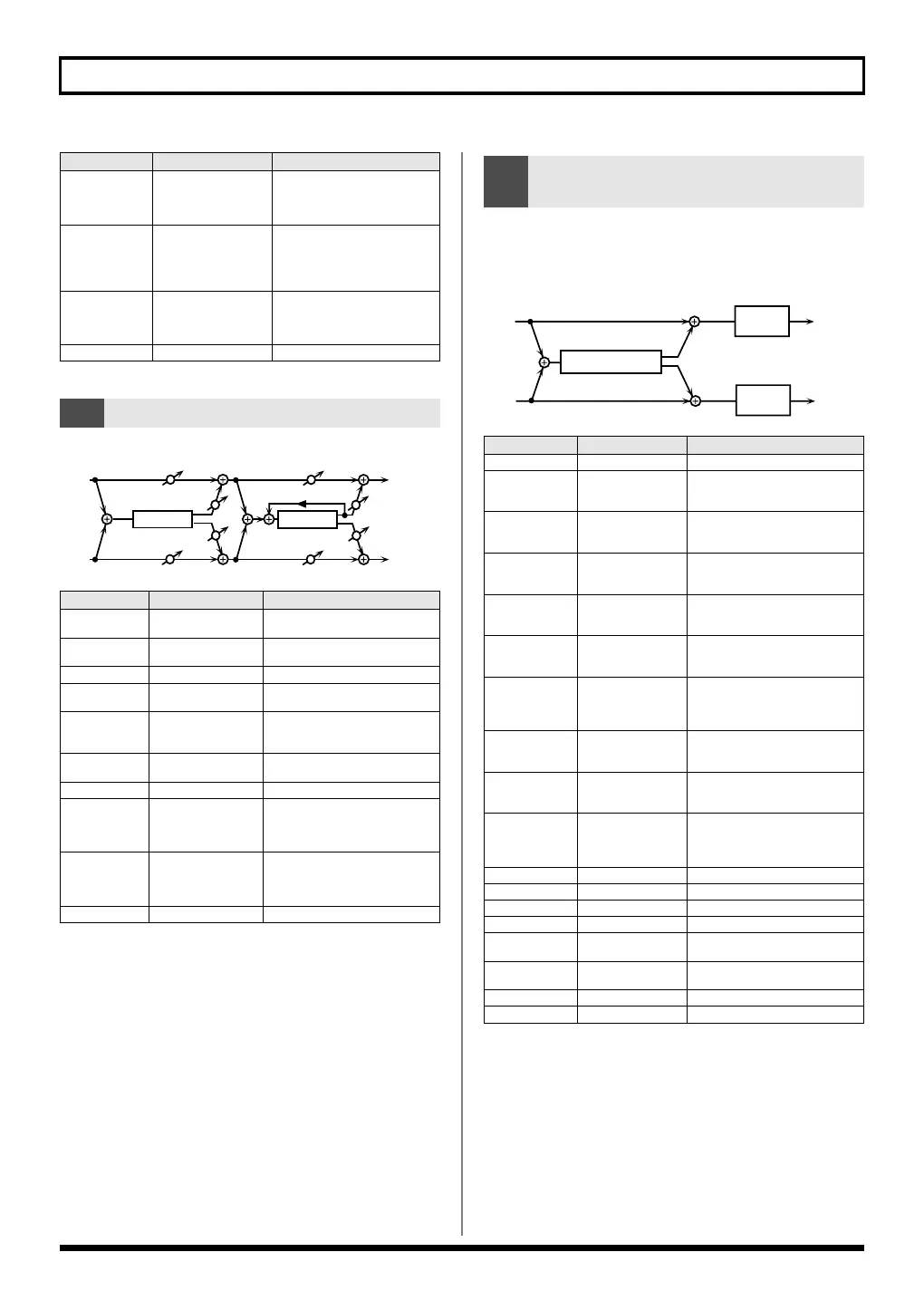218
Effects List
fig.MFX-77
On an acoustic piano, holding down the damper pedal allows
other strings to resonate in sympathy with the notes you play,
creating rich and spacious resonances. This effect simulates
these sympathetic resonances.
fig.MFX-78
Delay
Feedback #
-98– +98%
Adjusts the proportion of the de-
lay sound that is fed back into the
effect. Negative (-) settings will in-
vert the phase.
Delay HF Damp
200–8000 Hz,
BYPASS
Adjusts the frequency above
which sound fed back to the effect
will be cut. If you do not want to
cut the high frequencies, set this
parameter to BYPASS.
Delay
Balance #
D100:0W–D0:100W
Adjusts the volume balance between
the sound that is sent through the de-
lay (W) and the sound that is not sent
through the delay (D).
Level
0–127
Output Level
77:
CHORUS
→
FLANGER
Parameter
Value Description
Cho Pre Delay
0.0–100.0 ms
Adjusts the delay time from the direct
sound until the chorus sound is heard.
Cho Rate #
0.05–10.00 Hz, note
Modulation frequency of the chorus
effect
Cho Depth
0–127
Modulation depth of the chorus effect
Cho Balance #
D100:0W–D0:100W
Volume balance between the direct
sound (D) and the chorus sound (W)
Fln Pre Delay
0.0–100.0 ms
Adjusts the delay time from when
the direct sound begins until the
flanger sound is heard.
Fln Rate #
0.05–10.00 Hz, note
Modulation frequency of the flanger
effect
Fln Depth
0–127
Modulation depth of the flanger effect
Fln Feedback #
-98– +98%
Adjusts the proportion of the flanger
sound that is fed back into the ef-
fect. Negative (-) settings will invert
the phase.
Fln Balance #
D100:0W–D0:100W
Adjusts the volume balance between
the sound that is sent through the
flanger (W) and the sound that is not
sent through the flanger (D).
Level
0–127
Output Level
Parameter
Value Description
Feedback
Flanger
L in
R in
L out
R out
Balance W
Balance W
Balance D
Balance D
Chorus
Balance W
Balance W
Balance D
Balance D
78:
SYM RESONANCE
(SYMPATHETIC RESONANCE)
Parameter
Range Explanation
Depth #
0–127
Depth of the effect
Damper #
0–127
Depth to which the damper pedal is
pressed (controls the resonant
sound)
Pre LPF
16–15000 Hz,
BYPASS
Frequency of the filter that cuts the
high-frequency content of the input
sound (BYPASS: no cut)
Pre HPF
BYPASS,
16–15000 Hz
Frequency of the filter that cuts the
low-frequency content of the input
sound (BYPASS: no cut)
Peaking Freq
200–8000 Hz
Frequency of the filter that boosts/
cuts a specific frequency region of
the input sound
Peaking Gain
-15– +15 dB
Amount of boost/cut produced by
the filter at the specified frequency
region of the input sound
Peaking Q
0.5, 1.0, 2.0, 4.0,
8.0
Width of the frequency region
boosted/cut by the ‘Peaking Gain’
parameter (larger values make the
region narrower)
HF Damp
16–15000 Hz,
BYPASS
Frequency at which the high-fre-
quency content of the resonant
sound will be cut (BYPASS: no cut)
LF Damp
BYPASS,
16–15000 Hz
Frequency at which the low-frequen-
cy content of the resonant sound will
be cut (BYPASS: no cut)
Lid
1–6
This simulates the actual changes in
sound that occur when the lid of a
grand piano is set at different
heights.
EQ Low Freq
200, 400 Hz
Frequency of the low-range EQ
EQ Low Gain
-15– +15 dB
Amount of low-range boost/cut
EQ Mid Freq
200–8000 Hz
Frequency of the midrange EQ
EQ Mid Gain
-15– +15 dB
Amount of midrange boost/cut
EQ Mid Q
0.5, 1.0, 2.0, 4.0,
8.0
Width of midrange (larger values
make the region narrower)
EQ High Freq
2000, 4000, 8000
Hz
Frequency of the high-range EQ
EQ High Gain
-15–+15 dB
Amount of high-range boost/cut
Level
0–127
Output Level
L in
R in
L out
R out
Sym. Resonance
3-Band
EQ
3-Band
EQ
SonicCell_e.book 218 ページ 2007年8月9日 木曜日 午後9時17分

